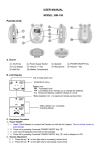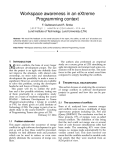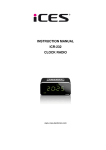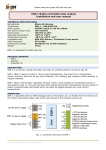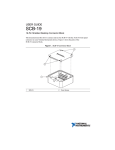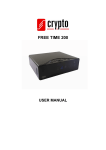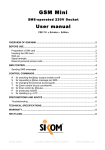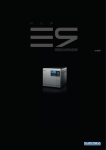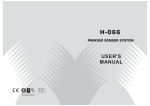Download Manual AVRSLRN
Transcript
SELF LEARNING PARKING SENSOR KIT USER MANUAL AVRSLRN AVRSLRN Self Learning Parking Sensor Kit Parking sensor system consists of 4 ultrasonic sensors, digital control MCU and buzzer. It detects the distance between a vehicle and obstructions using the ultrasonic sensors installed into the rear bumper (allowing tow bar fitment), with stage warning sound function. The driver can judge the distance to avoid collisions. MAIN FEATURES 1. 2. 3. 4. 5. 6. 7. 8. Choose correct installation position for the sensors Select drilling position for sensor A & D Select drilling position for sensor B & C Locate the position and drill Install the sensors and hide wires Install the buzzer Install the control box Connect the whole system according to the General Installation Diagram INSTALLATION AND TEST "BiBi" alarm sound Hidden installation Sensitivity adjustable switch 70dB buzzer Fitment to vehicles with tow bar or spare wheel NEW FEATURES Tow Bar function This system has a tow bar function. The system will not alarm if there is a tow bar on the rear of the vehicle. 20CM ON/OFF switch There is an ON/OFF switch on the rear of the control module. If set to “on” the alarm distance will be 20cm shorter than the real distance. This is designed to be used when a vehicle has a spare wheel on the rear. The system will detect the distance between the obstacle and spare tyre rather than between obstacle and bumper. TECHNICAL SPECIFICATIONS Rated Voltage: DC 12V Operating Voltage: DC 10.5 16V Rated Current: 20-200mA Detecting Distance: 0.2 2.5m Ultrasonic Frequency: 40KHz Controller Working Temperature : -30 ~+70 Buzzer Dimensions (LxHxD) 42x42x16mm INSTALLATION AND TEST 1. Adjust the direction of sensors and axial orientation. Neaten the wiring after installation of sensors. 2. Connect the red controller wire to the 12v+ reverse wire on the vehicle. Connect the black controller wire to the chassis of the vehicle. 3. Turn on vehicles ignition and select reverse gear. The system will initiate test procedure. TEST: A. When testing some sensors, if the buzzer gives continuous sound please check that there are no car parts or unwanted objects within the detecting range or that the sensors are not near to strong interference sources (such as exhaust pipes or other wires) and check that the sensors are not too tight; B. If the buzzer shows a distance but there are no objects in front of the sensors the system may be detecting the ground, in this case please check the position of sensors and their orientation and check that there are no car parts in the detection range; C. If the problem still cannot be rectified the whole system should be replaced. 4. Put a board (100cm x 20cm) within 2.5m in front of the sensors. The system should start warning procedure and sound indication of distance. NOTE ALARM MODE Di stance Awarenes s Al ar m sou nd 1 >1.5m Safety Ar ea Si len ce 2 1.0-1.5m Safety Ar ea Bi.........Bi......... 3 0.7-0.9m Al ar m Ar ea Bi......Bi...... 4 0.4-0.6m Al ar m Ar ea Bi...Bi... 5 <0.3m Danger Area Bi... Stages INSTALLATION STEPS 1. When installing the system, the vehicles engine should be off. 2. The performance of the sensors may be affected by the following situations: Heavy rain, loose gravel roads, bumpy/ uneven roads, extreme heat or cold conditions, moist weather and if the sensors are covered in snow, ice or mud. 3. Other ultrasonic or electronic waves may affect the performance of the system. 4. The sensors should not be installed too tight or too loose. Ensure that the supplied drill bit is used. 5. Do not install the control unit or sensors close to other interference sources such as exhaust pipes or vehicles wiring. 6. Test the system to make sure it operates correctly before using. 7. This system acts only as a reminding aid, in the case of any accident the manufacturer or distributer is not responsible. 5. Sensor Installation 2. Select drilling position for sensor A & D A. Choose a suitable drilling position for A & D sensor with relevant mark. D A. Insert the sensors into the holes with the arrows facing up up Sensor B. To perform the best detecting angle, select the position for A & D sensor ideally 8-13cm away from side, 11cm is recommended. A B. Hide the wires in good order according to various cars. 3. Select drilling position for sensor B & C A D A. Measure the distance between sensor A and D, to get the result "L". B. Mark sensor B & C for every 1/3 "L" interval. B 6. Control Box Locate the control box in the boot, keep safe, cool, dry and away from shake and interference. A 7. Sensor Detecting 4. Drilling 2.5m Drill with a small bit to locate Drill with the supplied hole cutter SENSOR INSTALLATION DIAGRAM Objects that are difficult to detect Smooth slope Smooth round objects Objects absorbing wave, e.g. Cotton INSTALLATION TOOLS 0.5-0.8m Be sure no other parts of the vehicle fall into the detecting range of the sensors. 0.3-0.4m 0.6-0.8m The best position for 2 sensors The best position for 4 sensors Pay attention to the direction of the sensor up 1. Advised position to install the sensors up up up up A B C D A. 4 drilled holes (A,B,C,D) should be under the same line. B. 0.5-0.8m vertically high to the ground, 0.55 is recommended C. Vertical, tidy surface is preferred. Vertical installation position to the ground GENERAL INSTALLATION DIAGRAM DETECTING RANGE Control box Buzzer Top View C D Reversing light A B D C ns Se A or B Side View 20 cm on/off function Buzzer ON OFF Control box A B C D Buzzer Power wire Adjust Sensitivity ) A B C D Sensor installation height adjustable from 45 to 55cm Buzzer





